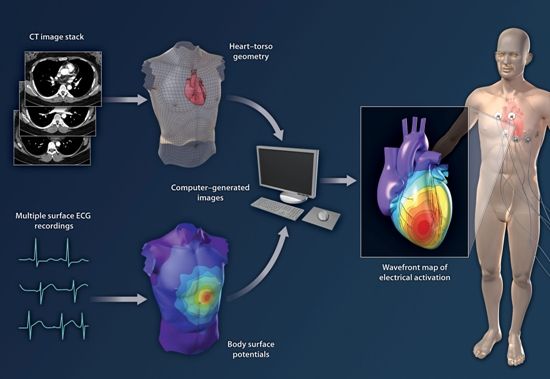New ECG/CT Technique Pinpoints Cause of Abnormal Heartbeat
A new technique combining electrocardiographs (ECG) and computed tomography (CT) paints a more accurate picture of the electrical activity of a beating heart, according to a new study. The technique, which its inventors call electrocardiographic imaging, or ECGI, can pinpoint the precise origins of abnormal heart rhythms and could improve diagnosis and treatment of this fatal condition.
A new technique combining electrocardiographs (ECG) and computed tomography (CT) paints a more accurate picture of the electrical activity of a beating heart, according to a new study in Science Translational Medicine. The technique, which its inventors call electrocardiographic imaging, or ECGI, can pinpoint the precise origins of abnormal heart rhythms and could improve diagnosis and treatment of this fatal condition, University of Washington in St. Louis researchers reported.
More than 7 million people worldwide die annually from abnormal heart rhythms or cardiac arrhythmias, and many more are disabled. Yet there has been no imaging technique available to identify patients at risk, provide accurate diagnosis, or guide therapy. The electrocardiogram, a decades-old tool for measuring the electrical activity of the heart, captures only an approximate, distorted view of a beating heart.
Combining ECG recorded using multi-electrode vests with torso CT scans, Yong Wang, PhD, and colleagues pinpointed the origins of abnormal heartbeats in 25 patients. The authors combined the inputs to understand the electrical behavior of arrhythmic hearts, creating a detailed map of electrical activation and tracing the origin of the abnormal heart rhythm.
The team correctly identified the origin of rhythms in more than 90 percent of patients, they reported. Wang and colleagues confirmed these results with the standard catheter-based electrophysiology study.
The results show that an ECGI can give doctors information comparable to the current procedure for mapping abnormal heart activity without the need for intravenous needles or anesthetics. Moreover, the ECG/CT approach enables the mapping of single heartbeats and give high-resolution images of the heart’s ventricles, an improvement over the simplified shadow that standard techniques provide.

Could Lymph Node Distribution Patterns on CT Improve Staging for Colon Cancer?
April 11th 2025For patients with microsatellite instability-high colon cancer, distribution-based clinical lymph node staging (dCN) with computed tomography (CT) offered nearly double the accuracy rate of clinical lymph node staging in a recent study.
The Reading Room Podcast: Current Perspectives on the Updated Appropriate Use Criteria for Brain PET
March 18th 2025In a new podcast, Satoshi Minoshima, M.D., Ph.D., and James Williams, Ph.D., share their insights on the recently updated appropriate use criteria for amyloid PET and tau PET in patients with mild cognitive impairment.
Could Ultrafast MRI Enhance Detection of Malignant Foci for Breast Cancer?
April 10th 2025In a new study involving over 120 women, nearly two-thirds of whom had a family history of breast cancer, ultrafast MRI findings revealed a 5 percent increase in malignancy risk for each second increase in the difference between lesion and background parenchymal enhancement (BPE) time to enhancement (TTE).
AMA Approves Category III CPT Codes for AI-Enabled Perivascular Fat Analysis from CT Scans
April 9th 2025Going into effect in 2026, the new CPT codes may facilitate increased adoption of the CaRi-Heart software for detecting coronary inflammation from computed tomography scans pending FDA clearance of the technology.